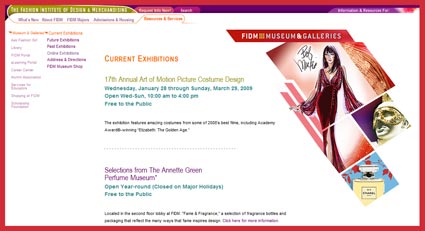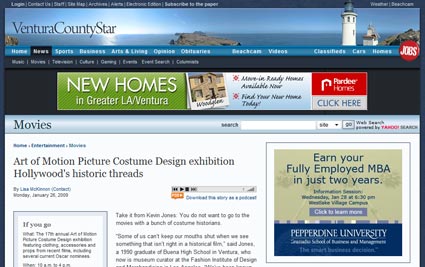Today’s Ventura County Star features an article about the Fashion Institute of Design & Merchandising (FIDM) and their 17th annual Art of Motion Picture Costume Design exhibition, which opens Wednesday. Costumes from some of the more notable films of 2008 will be on display at the FIDM Museum & Galleries at the Los Angeles Campus, including many wardrobe pieces from movies recently nominated for Academy Awards.
The exhibition will run through March 29, 2009 and is free to the public. More details about the exhibition can be found at the FIDM.edu website: LINK
There is a news story about the exhibition in the Ventura County Star (see Art of Motion Picture Costume Design exhibition Hollywood’s historic threads):
Art of Motion Picture Costume Design exhibition Hollywood’s historic threads
By Lisa McKinnon
Monday, January 26, 2009Take it from Kevin Jones: You do not want to go to the movies with a bunch of costume historians.
“Some of us can’t keep our mouths shut when we see something that isn’t right in a historical film,” said Jones, a 1990 graduate of Buena High School in Ventura, who now is museum curator at the Fashion Institute of Design and Merchandising in Los Angeles. “We’ve been known to talk very loudly amongst ourselves.”
But a scene in “The Duchess,” which stars Keira Knightley as an 18th-century, powdered-wig-wearing ancestor to Princess Diana, managed to stun Jones into silence.
Knightley’s character’s new husband uses a pair of scissors to cut her out of a tight-fitting gown. Then he unlaces her corset and allows her chemise to fall away, revealing weltlike lacing marks on her skin.
“That detail is so correct, and yet you never see it in the movies. It’s one of my favorite costume moments – and it didn’t even have any clothes in it,” Jones said with a laugh.
He wasn’t surprised last week when “The Duchess” was named one of the five Oscar nominees for best costume design. By then, he’d already seen the costumes in person, while wrestling them – and their dressmaker’s form-style mannequins – out of coffin-size wooden packing crates and onto a raised platform in the FIDM Museum & Galleries.
There, they will be joined by costumes, accessories and props from more than 20 other films for the Art of Motion Picture Costume Design exhibition, which will open to the public on Wednesday and remain on view through March 29.
“Movies bring what we study to life,” said Jones, dressed for exhibit pre-opening battle in jeans, knee pads, a back brace and a museum smock with safety pins hanging from the pockets.
“This exhibit celebrates all aspects of costume design for the movies, whether they’re historical or contemporary, big and grand or small and independent.”
And the nominees are…
Still, there’s no mistaking the exhibit’s link to the glittering glamour of the Academy Awards.
Now in its 17th year, it traditionally opens right after the nominations are announced and runs for at least a month after the awards ceremony. It usually features an encore presentation of the Oscar-winning costumes from the previous year. And it almost always includes most, if not all, of the current nominees for best costume design.
The exhibit this year will include the 1970s-era T-shirts and suits designed by first-time nominee Danny Glicker for “Milk”; two silk taffeta gowns and a coat designed for actor Ralph Fiennes by first-time nominee Michael O’Connor for “The Duchess”; and a half-dozen pieces created for “The Curious Case of Benjamin Button” by Jacqueline West, previously nominated for “Quills” in 2000.
Missing will be costumes from remaining nominees Catherine Martin, for “Australia,” and Albert Wolsky, for “Revolutionary Road.”
“We would love to have such-and-such a costume from such-and-such film. But the reality is, while a movie may be new to audiences, it often represents work done two years ago for a costumer” and the pieces might be long gone, Jones said.
“With costs going up, studios are not keeping costumes. They might sell them off right away, or donate them to a charity auction.” In other cases, the pieces are rentals that might already have been altered for use in another production, he said.
If he can’t get them from the studio or a designer, Jones sometimes resorts to borrowing costumes directly from the stars for whom they were made.
“Glenn Close, Julia Roberts, these are women who have the clout to have it written into their contracts that they can keep their costumes,” he said, noting that the museum once presented a display of “Erin Brockovich” costumes on loan from Roberts herself.
Star power
This year’s exhibit also has the purple-and-acid-green outfit worn by Heath Ledger on his way to a posthumous best supporting actor nomination as The Joker in “The Dark Knight.” It is eerily complete, down to the socks and battered suede shoes Ledger wore for the role.
Nearby, a display of costumes worn by Angelina Jolie for her Oscar-nominated role in “Changeling” includes the actress’ shoes and her vintage metal roller skates.
“We tried every which way to get the mannequin to stand still on the skates, then realized it wasn’t going to happen,” Jones said, laughing. Instead, the skates now dangle from the mannequin’s right hand.
Visitors also will be able to see how Tom Cruise measures up in his World War II uniforms from “Valkyrie,” and compare Meryl Streep’s roles as a nun in “Doubt” and a disco-dancing mother of the bride in “Mamma Mia!” thanks to the inclusion of her outfits from both films.
Also, just how tiny is Renee Zellweger? For the answer, check out the bustled gowns she wore in the Western “Appaloosa,” displayed on mannequins originally intended to approximate the size of a 13-year-old.
Pressing matters
Some costumes arrive for the exhibit already on mannequins and dressmaker forms. Others are delivered folded up in everything from suitcases to archival blue board boxes and have to be coaxed onto stiff-armed mannequins.
That’s where Shelly Foote of Ventura comes in. A fellow costume historian who retired several years ago from the Smithsonian’s National Museum of American History in Washington, D.C. – and, coincidentally, a fellow Buena High School grad (class of 1966) – Foote knows her way around an unyielding elbow and other fiberglass body parts.
“Kevin calls me when he needs someone who can dress mannequins,” said Foote, who remains active with the Western Region of the Costume Society of America.
But on a recent day, Foote was instead steaming wrinkles out of costumes that already had been put onto mannequins. She started with a 1940s-era rayon crepe dress worn by Abbie Cornish in “Stop-Loss” before moving on to a lacy purple gown from the globe-trotting film “The Fall” and a 16th-century-inspired dress worn by Scarlett Johansson in “The Other Boleyn Girl.”
“These are like museum pieces and … you don’t iron them because the combination of heat and pressure is bad for the fibers,” Foote said. “Steaming relaxes the fibers so they at least look a little neater.”
Foote also waved her steam wand over a red, short-sleeved, semi-backless dress worn by Cate Blanchett in “The Curious Case of Benjamin Button.” It was based on a dress created by American designer Claire McCardell in the 1950s that is now part of the FIDM museum’s permanent collection.
“That is the dress of the year, the way Keira Knightley’s green dress from ‘Atonement’ was the dress of last year,” curator Jones said. “And the designer came here to do her research for it.”
Was stickler-for-accuracy Jones as quiet during “Benjamin Button” as he was for “The Duchess?”
“You have 60 years in one film,” he said of the reverse-aging process experienced by “Benjamin Button” star Brad Pitt. “That’s ideal for us costume geeks.”
Jason De Bord



